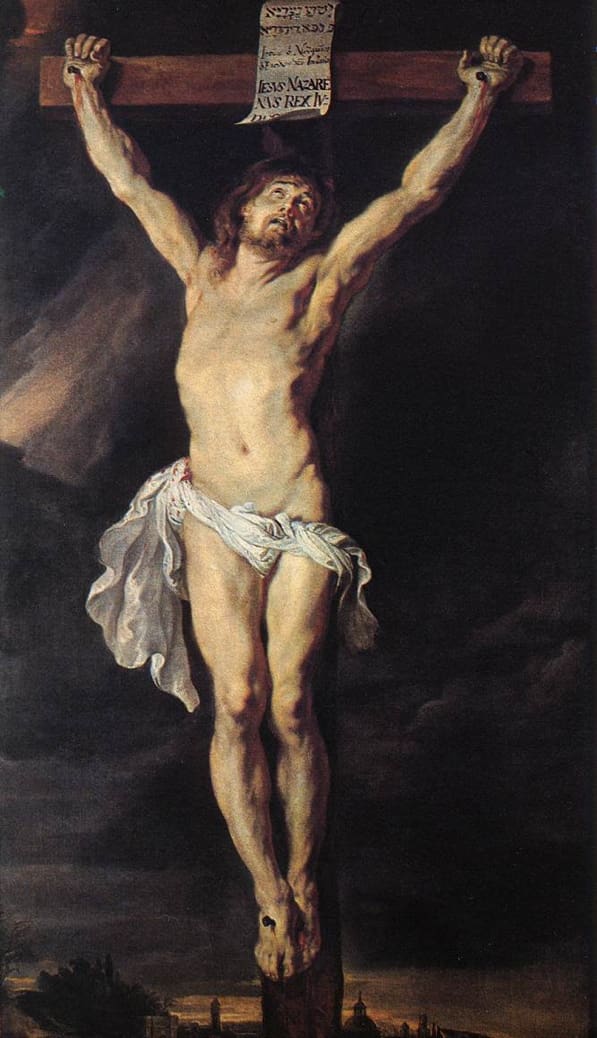Presence of God – O Jesus Crucified, make me understand that the Cross is the greatest proof of love.
MEDITATION
 After the Incarnation, the Cross of Jesus is the greatest proof of His love for man. Similarly, mortification, which is suffering eagerly accepted for the love of God, is one of the greatest proofs of love that we can give Him. It means freely giving up a satisfaction or a pleasure in order to impose on ourselves, for love of God, something which is contrary to our own natural inclinations; we thus prove that we prefer to satisfy God rather than ourselves. Every act of voluntary mortification, whether physical or moral, says to God, “Lord, I love You more than myself!” And since a soul in love has an ardent desire to give proof of its love, it is very vigilant not to miss a single opportunity for renunciation.
After the Incarnation, the Cross of Jesus is the greatest proof of His love for man. Similarly, mortification, which is suffering eagerly accepted for the love of God, is one of the greatest proofs of love that we can give Him. It means freely giving up a satisfaction or a pleasure in order to impose on ourselves, for love of God, something which is contrary to our own natural inclinations; we thus prove that we prefer to satisfy God rather than ourselves. Every act of voluntary mortification, whether physical or moral, says to God, “Lord, I love You more than myself!” And since a soul in love has an ardent desire to give proof of its love, it is very vigilant not to miss a single opportunity for renunciation.
It was in this sense that St. Teresa Margaret of the Heart of Jesus resolved “not to let a single occasion for suffering escape, as far as she was able–and always in silence between God and herself.” In fact, she made every effort “to find at each moment some occasion for suffering or bodily pain, so as never to satisfy the slightest appetite or desire, and she sought ways to make even what was necessary, painful and wearying to her body” (Spirituality of St. Teresa Margaret of the Heart of Jesus). Her ardent love for God found an outlet in this generous, untiring exercise of mortification.
Using a different expression, St. Thérèse of the Child Jesus called this practice “scattering flowers,” that is, profiting by every least opportunity to suffer in order to give God a proof of her love. Knowing that the value of mortification depends upon the generosity of the dispositions with which it is done, the Saint said, “I shall always sing, even should my flowers be gathered from the midst of thorns” (Story of a Soul, 13).
COLLOQUY
“O my Beloved, how shall I show my love, since love proves itself by deeds? I have no other means of proving my love than to strew flowers, and these flowers will be each word and look, each little daily sacrifice. I wish to make profit out of the smallest actions and to do them all for Love. For Love’s sake I wish to suffer and to rejoice: so shall I strew my flowers. Not one that I see but, singing all the while, I will scatter its petals before You. Should my roses be gathered from amid thorns, I will sing notwithstanding; and the longer and sharper the thorns, the sweeter will grow my song” (St. Thérèse of the Child Jesus, Story of a Soul, 13).
“O Lord, dispose of me according to Your will, for I am content with everything if only I am following You on the road to Calvary. The more thorns there are on this road and the heavier the Cross is, the more consoled shall I be, for I desire to love You with an effective love, with a patient love, with a love which is dead to self and entirely surrendered to You. O Lord, You on the Cross for me and I on the Cross for You! Oh! if I could but once understand how sweet and precious it is to suffer: to suffer in silence for You, O Jesus! O dear suffering! O good Jesus!” (St. Teresa Margaret of the Heart of Jesus, Spirituality of St. Teresa Margaret of the Heart of Jesus). Yes, suffering is dear to me because it permits me to give God proofs of my love; because in the darkness of faith, in which I must live here below, it gives me the assurance of loving not only in words, but with a strong, effective love. O Jesus, now I understand why St. Teresa of Avila asked for only one thing: “to die or to suffer,” professing to have no other reason for living except to suffer for love of You (Life, 40).
O Lord, may I too have such strong, true, and ardent love! Grant it to me, You who can give me all things, and who can, in one instant, transform this dry, cold heart into a furnace of charity.
Note from Dan: These posts are provided courtesy of Baronius Press and contain one of two meditations for the day. If you would like to get the full meditation from one of the best daily meditation works ever compiled, you can learn more here: Divine Intimacy. Please honor those who support us by purchasing and promoting their products.
Art: The Crucified Christ, Peter Paul Rubens, between 1610 and 1611, PD-US, Wikimedia Commons; Father Gabriel of St. Mary Magdalen, mirror from open source material.






